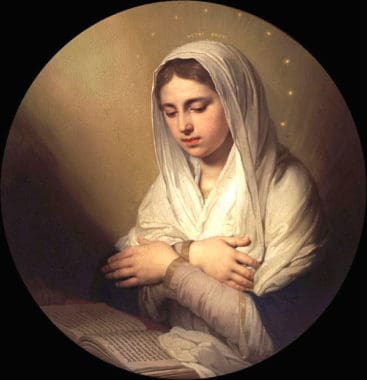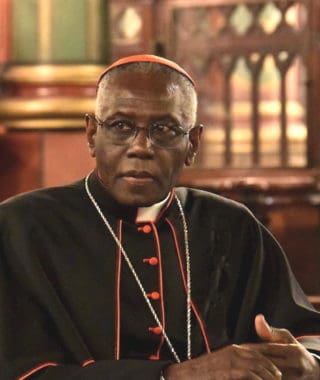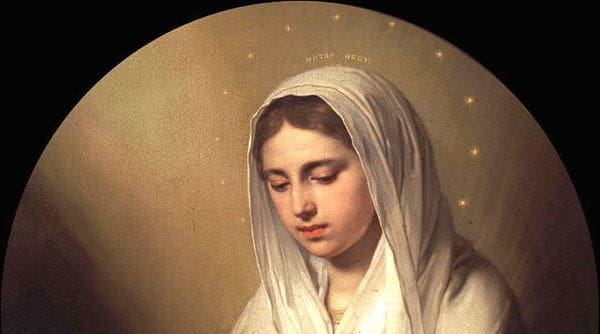Mysticism and the Machine
Mysticism and Magisterium Series Part V
The central truth running through this series of posts on “mysticism and magisterium” is the active and effective presence of Christ in the Church. This affirmation is not an abstraction, but a fact realized in all the circumstances of history.
The Church is a person, not a thing and our relationship with “her” is sacramental, organic and mystical, not mechanical or magical. Christ lives in and through the Church, and through the Church we live in Christ.
Reflect on the previous posts’ titles: Thinking with the Church; Christ Yesterday, Today and Forever; Christ the One Teacher of All; Christ the Good Shepherd. It’s all really about divine providence and the way it is exercised through the person of the Eternal Word who has entered history by being made flesh to dwell among us.
The result of the Incarnation and Redemption is an organic unity we call the Mystical Body of Christ, or the Church. As the Mystical Body of Christ, the Church is the unity of both head and body, and is mystical because it is joined to a divine Head who governs and guides it in the first person—as an “I” and not merely a distant “Him.”
According to St. Augustine, this means that Christ is not to be taken merely as an individual, but in His fullness with the whole Church and with all its members. It also means that the Church is not a what, but a who—not merely a body guided by a head, but the whole Christ.
This is not pantheistic confusion between God and creatures, but the full realization of the Incarnation. In the words of St. Augustine, God became man, so that man might become God. The Eastern Church uses the word “divinization.” In the West we call it sanctification. Through God’s grace, received especially in the sacraments in the Church, we become more and more identified with Christ, without, however, ceasing to be a mere creatures.
So if the Church has a personal identity, and that identity is Christ, why then do spiritual writers so often refer to the Church as a “she”? The reason is precisely that in our real identification with Christ there remains a distinction between Christ the Head and the members of His Body—between the God-man and the purely human creature. But just as important is the fact that the Church finds is finest example, and even its Mother, in the person of the Blessed Virgin Mary.
 Our Lady is the human creature par excellence who realizes fully, in Her own person, what the Church is meant to be. She is the one who most perfectly identifies with Christ, Her Son. Both the Church and Our Lady are one with Christ. Both the Church and Our Lady are our Mother and Teacher: the Church through her sacraments and doctrine; Our Lady through Her mediation and example.
Our Lady is the human creature par excellence who realizes fully, in Her own person, what the Church is meant to be. She is the one who most perfectly identifies with Christ, Her Son. Both the Church and Our Lady are one with Christ. Both the Church and Our Lady are our Mother and Teacher: the Church through her sacraments and doctrine; Our Lady through Her mediation and example.
In the years following the Second Vatican Council, Joseph Ratzinger came to understand the importance of this truth. Earlier in his life, he had thought the ancient patristic maxim: de Maria numquam satis (“concerning Maria there is never enough”) was a pious exaggeration. But later he realized that this was not the case at all because, in a real way, Mary reveals the true identity of the Church. Indeed, Fr. Ratzinger came to understand the truth of the saying that Mary is “the vanquisher of all heresies”; Her personal identification with the Church assures She will never be reduced to a thing or program. Joseph Ratzinger lamented:
We treat the Church almost like some technological device that we plan and make with enormous cleverness and expenditure of energy. Then we are surprised when we experience the truth of what Saint Louis-Marie Grignon de Montfort once remarked, paraphrasing the words of the prophet Haggai, when he said, “You do much, but nothing comes of it” (Hag 1:6). When making becomes autonomous, the things we cannot make but that are alive and need time to mature can no longer survive (The Church at the Source, 16).
To counter this, Joseph Ratzinger reminds us that Mary is “transparent to the personal form of the Church,” and the guarantee that the Church will not be treated as a merely a “program of action” or a “product of our creation and design.”
Thus, doctrinally sound devotion to Mary is an important part of reform and renewal in the Church today. In Her light, the projects of social engineering, such as the attempt to reinvent holy matrimony as something other than an indissoluble bond between one man and one woman for life, are revealed as the monstrosities that they are.
Likewise, through Mary we can come to better appreciate that the sacraments and liturgy are not production factories of grace. There are no fuel-saving nor high-performance sacramental engines.
 On the contrary, there is our baptismal relationship with Christ and the other sacramental means by which God gives us sanctifying grace, which grace is not a thing produced by the liturgy machine, but our participation in the life of God communicated to us through the sacraments. Certainly, we can celebrate the liturgy poorly in a way that is both unworthy of God and impotent to inspire faith, but as Cardinal Robert Sarah recently wrote, we should cease to allow the liturgy to be “the locus of rivalries and criticisms,” so that “we will be brought at last to participate actively,” in the mystery of Christ glorified. In the liturgy, we encounter, not a “what” but a “who.”
On the contrary, there is our baptismal relationship with Christ and the other sacramental means by which God gives us sanctifying grace, which grace is not a thing produced by the liturgy machine, but our participation in the life of God communicated to us through the sacraments. Certainly, we can celebrate the liturgy poorly in a way that is both unworthy of God and impotent to inspire faith, but as Cardinal Robert Sarah recently wrote, we should cease to allow the liturgy to be “the locus of rivalries and criticisms,” so that “we will be brought at last to participate actively,” in the mystery of Christ glorified. In the liturgy, we encounter, not a “what” but a “who.”
Also through Mary, we learn that the Church is greater than the sum of its parts. It is reducible neither to the human ingenuity of its leaders nor of the insurgents who are convinced that the magisterium is leading the Church to hell. But this is only something we can see clearly and act wisely upon if our devotion to Mary is authentic.
Such devotion is primarily an interior disposition, which is the fruit of prayer. All the saints, including the great Marian apostle St. Maximilian Kolbe, who was a man of vigorous action, taught that activity is of somewhat secondary importance when compared with prayer. This is because supernatural goals can only be accomplished by supernatural means. You do much, but nothing comes of it, the prophet Haggai says. The apocalyptic combox* agitation might make us feel better, but it does not change anything. Our words and actions must proceed from a deep union with God. The more difficult our problems, the more essential that union becomes.
As the Church is not a machine, so devotion to Mary, the liturgical reform of the reform or restoration, the reform of the Roman curia, of our seminaries and religious communities, are not levers to be pulled or buttons to be pushed. On the contrary, they can only be the fruit of grace and conversion, and the further means for us to enter more deeply into the mystery of Christ, which we find in His Mystical Body, the Church.
*combox: communications box where someone writes their comments to a post.
Art: The Virgin Mary (From The Annunciation. Icon from the royal gates of the central iconostasis of the Kazan Cathedral in St.-Petersburgh, Vladimir Borovikovsky, 1804-1809rr, PD-US; Detail of Modified version of Image:Ratzinger Szczepanow 2003 5.jpg, Marian Lambert, May 10, 2003 (released by Szamil), CCA; Mirror of modified Le Cardinal Robert Sarah (Cardinal Robert Sarah), François-Régis Salefran, 5 March 2015, own work, CCA-SA; all Wikimedia Commons.


